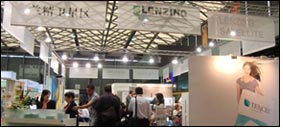 Lola Mansil
Lola Mansil Weronika Kumanek
Weronika Kumanek Austin Levine
Austin Levine Marie M
Marie M Mikko Puttonen
Mikko Puttonen
 The British Fashion Council (BFC) announced the provisional schedule of designers who will be showcasing their autumn/winter 2011 collections at London Fashion Week (LFW) in February.
The British Fashion Council (BFC) announced the provisional schedule of designers who will be showcasing their autumn/winter 2011 collections at London Fashion Week (LFW) in February.
Returning to show on schedule this season are luxury British brand Aquascutum and Temperley London, who celebrate their 10th anniversary. They will join current LFW catwalk designers including Antonio Berardi, Burberry Prorsum, Jonathan Saunders, Matthew Williamson and Pringle of Scotland, as well as our emerging BFC NEWGEN sponsored by Topshop talents.
New to the presentation schedule for February are J. JS Lee and Les Chiffoniers.
British heritage menswear brand, Alfred Dunhill, will show at London Fashion Week, hosting an intimate style salon show on Tuesday evening as a prelude to Menswear Day, Wednesday 23rd February.
Showing at LFW’s dedicated Menswear Day for the first time is Cassette Playa, who will be showcasing her luxury streetwear collection on the catwalk.
Modern menswear tailoring label Mr Start and luxury heritage brand Bally will debut at London Fashion Week in February. Both will show their collections on the presentation schedule for Menswear Day.
London Fashion Week will run from Friday 18th – 23rd February 2011 and will be located at Somerset House, Strand WC2.
Following a six-year "pause", here is the first look on Tom Ford’s comeback to womenswear collection photographed by Steven Meisel for the December 2010 issue of Vogue US starring models Carolyn Murphy, Anja Rubik, Joan Smalls, Stella Tennant, Amber Valletta, Karen Elson and Edita Vilkeviciute.

"I want this to be somewhere a woman knows she can go when she wants a great jacket—not a fake expensive jacket, something that has intrinsic value," says Ford of the collection. "I don’t think fashion has to change every five minutes. I’d like these to be clothes you can wear for a long time—ten, 20 years; pass on to your daughter. Why buy vintage when you can open your own closet!”
NY futures continued their remarkable ascent this week, with March rallying another 1017 points to close at 146.12 cents, while new crop December gained a respectable 239 points to close 96.75 cents.
Last week we commented on what we believe to be a disproportionately large futures short position by the trade, considering how little cotton is left for sale. To our astonishment the latest spec/hedge report by the CFTC showed a further expansion of open positions last week, as trade longs added 6'782 contracts and trade shorts increased their position by 6'914 contracts.
In other words, instead of getting out of harms way, there are even more players joining this dangerous game called "picking a top", among them mills with their still more than 10.0 million bales in unfixed on-call sales. While some shorts represent legitimate hedges, many of them are simply based on a speculative view that the market will sooner or later have to collapse.
We can certainly understand the temptation to short the cotton market after its spot price has doubled in less than five months. However, with most of this season's supply already committed and with mills seemingly still able to operate at these elevated prices, it is anybody's guess as to where and when the top will ultimately be made.
As we pointed out last week, the mostly trade-related shorts may find themselves in a trap from which it could prove difficult to escape, since many of the longs are either not able (index funds only roll at certain times) or not willing (hedge funds stay with the trend) to sell their current positions.
Some March shorts have chosen to roll into May and July at never before seen inversions, willing to sacrifice over 20 cents in roll penalty in the hope of getting the big selloff at some point down the road. Instead they may be condemned to live though the same nightmare again when May and July move into the limelight.
The bears can't expect much help from the physical market either, since sellers feel absolutely no pressure to dispose of the limited positions they still own. The A-index was quoted at a new all-time high of 173.40 as the cash market continues to outperform NY futures.
When we look at the US situation, not only did the USDA lower the US crop to 18.27 million bales in its latest report, but we also continue to see relatively strong export demand despite the limited availability. Last week US export sales amounted to 198'400 running bales for the current season and another 60'000 bales for next marketing year. Total commitments now amount to 14.0 million statistical bales for this season and 1.6 million bales for August onward shipment, most of which will be drawn from existing stocks.
If we add domestic mill use of 3.6 million bales for the current marketing year as well as 1.0 million bales for August to October consumption, we arrive at total commitments of 20.2 million bales, which compares to total supply of 21.2 million bales (2.9 million beginning stocks + 18.3 million bales crop). This means that the US is for all practical purposes sold out!
A true bull market is always demand-driven and that certainly seems to be the case here! Despite a doubling of prices we have yet to see evidence of any significant demand destruction, especially in fast growing markets like China and India. China reported the second-highest yarn output number ever for November, a sign that these higher prices have yet to curb demand.
This week PricewaterhouseCoopers in Hong Kong released a report according to which retail sales in China are expected to double to 4.6 trillion dollars by 2014. For the next four years, average growth of China's retail sales will be around 13%-14% annually, which compares to an overall 6% increase for the entire Asia-Pacific region.
In the first eleven months of this year retail sales in China grew by 18.4% compared to the corresponding period last year, according to the National Bureau of Statistics. The main drivers behind this strong domestic growth are increased worker incomes and government measures that stimulate domestic consumption.
Car sales are another gauge for China's phenomenal growth. Between January and November of this year China sold more than 16 million vehicles, which represents a 34% increase over the same period last year. This marks the second year in which Chinese consumers have bought more cars than their US counterparts. US sales totaled 'just' 10.4 million units for the first eleven months of this year. Vehicle sales in China are expected to grow to 20 million units in 2011 and one has to assume that if Chinese consumers can afford that many new cars, they will also be able to buy clothes and home textiles in increasing numbers.
So where do we go from here? The market has now moved within striking distance of its record high, which for March is at 151.23 cents on a closing basis and 151.95 cents intra-day. If these highs are taken out, we will likely see additional momentum players come in on the long side, which has the potential to trigger a short-covering rally similar to the one we experienced in early 2008.
The bears are of course hoping for the market to stall out at around 150 cents, which could form a double top on the chart and set a sharp correction in motion. Needless to say the market is approaching a critical juncture, but given the circumstances we would feel more nervous being short than long. We still believe that unless a trader has a convincing reason to be in the market - and the necessary money to back up his bet - it would be best to get out of it altogether since it will only get thinner and more volatile as we move through the season.
 In order to rejuvenate the linen sector in Europe, the European Union (EU), the French government and a linen industry association - European Confederation of Linen and Hemp (CELC) is undertaking a campaign to boost the European linen industry, backed by funding amounting to more than €3.3 million or US $4.6 million.
In order to rejuvenate the linen sector in Europe, the European Union (EU), the French government and a linen industry association - European Confederation of Linen and Hemp (CELC) is undertaking a campaign to boost the European linen industry, backed by funding amounting to more than €3.3 million or US $4.6 million.
Europe is worldwide leader in linen fiber, accounting for 85% of the total production. Linen is cultivated at close proximity in fields located in an area extending from Southern Normandy to Belgium and The Netherlands. Considering its ecological profile, linen is much better than other natural fibers which consume a huge amount of water. Due to the temperate and rainy climate, it needs neither irrigation nor fertilizer. Naturally, linen is also an ethical product that contributes to maintaining the economic and social cloth of rural areas.
As Europe’s unique agro-industrial network, the European linen industry integrates know-how and technologies specific to growing and transforming the fiber (from scotching to weaving or knitting) that are derived from European traditions and cultures. This heritage, transmitted from generation to generation, has produced an industry viable for the long term since the companies involved are committed to respecting the by-laws of the International Labor Organization (ILO).
The European Confederation of Linen and Hemp is the only European agro-industrial organization federating all the stages of production and transformation for linen & hemp. It is the privileged spokesperson for 10,000 European companies and oversees the fiber’s development from plant to finished product.
Created in 1951, the CELC incites reflection, market analyses, industry concentration and strategic orientations. With its ‘CELC Masters of Linen’ promotional platform, the confederation creates an ideal competitive environment for industry companies. Its actions, inscribed in an international context, stimulate innovation and rely on the value of these natural fibers with their proven environmental qualities.
"Until 2010, European linen fiber was 100% supported financially by its 10,000 members from 14 countries. In order to enhance our action plan and to launch new tools, especially for the retail and schools, we needed a complementary budget. With the support of the European Union and France, the ‘Be Linen’ program has now been launched for three years with a global budget of €3.3 million”, informed, Ms Marie-Emmanuelle Belzung, CELC General Secretary - Masters of Linen, exclusively to fibre2fashion.
Informing about the properties of the fiber, Ms Belzung said, “Linen is a 360 degree fiber which can be used all year long and not only during summer; is easy to care; is a sustainable fibre; is innovative and creative with “outdoor” and “knitting” for example and last but not the least linen is our future”,she concluded by saying.
 To help manufacturing and distribution organizations manage multi-attribute products, Oracle announced Oracle's JD Edwards EnterpriseOne Apparel Management. A new module within Oracle's JD Edwards EnterpriseOne 9.0 portfolio of integrated enterprise resource planning (ERP) applications, JD Edwards EnterpriseOne Apparel Management optimizes the management of products that consist of a variety of different attributes including styles, colors and sizes.
To help manufacturing and distribution organizations manage multi-attribute products, Oracle announced Oracle's JD Edwards EnterpriseOne Apparel Management. A new module within Oracle's JD Edwards EnterpriseOne 9.0 portfolio of integrated enterprise resource planning (ERP) applications, JD Edwards EnterpriseOne Apparel Management optimizes the management of products that consist of a variety of different attributes including styles, colors and sizes.
By accommodating the management of multi-attribute items, dynamic order priority allocations and seasonal collection lifecycles, JD Edwards EnterpriseOne Apparel Management supports the development of multi-attribute products from components to finished goods.
Built on the flexible, standards-based JD Edwards EnterpriseOne technology platform, the new module can also be used in other industries that manufacture and sell multi-attribute items such as food and beverage, consumer electronics or pulp and paper.
To further strengthen the JD Edwards EnterpriseOne applications suite, Oracle has also enhanced JD Edwards EnterpriseOne Tools by introducing new end user productivity features, system administration tools, reporting capabilities and additional platform certifications.
The new JD Edwards EnterpriseOne Tools 8.98.4 is compatible with JD Edwards EnterpriseOne 8.11, 8.12 and 9.0.
Supporting Multi-Attribute Products from Components to Finished Goods
JD Edwards EnterpriseOne Apparel Management delivers extensive functionality that supports the management of the entire lifecycle of multi-attribute products. The new module introduces:
Multi-Attribute Item Management: Supports complex multi-attribute products by providing the management capabilities and visibility needed to successfully accommodate different fabric compositions, cleaning codes and fabric label management.
Matrix Management: Ensures the consistency and maintainability of the whole product range by enabling the intuitive entry and maintenance of multi-attribute products and their related data within purchase orders, work orders and sales orders.
Collection Management: Supports data consistency across catalogs, seasonal offers and different order collection types whilst managing sales prices by seasons or collections.
Dynamic Order Allocation: Delivers an inventory allocation engine that is specifically designed to support the automation and flexibility needs of varying customer demand.
Seamless integration with JD Edwards EnterpriseOne financial management, customer relationship management, order management, manufacturing, supply chain planning, procurement and logistic modules further supports the management of multi-attribute products.
Supporting Quote
"To meet increasingly volatile and specific consumer expectations, manufacturers and distributors need to be able to streamline the management of complex multi-attribute items," said LyleEkdahl, Oracle group vice president, JD Edwards. "To help our customers address this challenge, Oracle has introduced JD Edwards EnterpriseOne Apparel Management. The new module delivers the extensive capabilities needed to manage multi-attribute items, dynamic order priority allocations and seasonal collection lifecycles. These capabilities can be applied to any industry that manufactures or sells multi-attribute items."
Makalot Industrial Co. – a leading garment manufacturer from Taiwan recently revealed that it has got export order from China-based popular garment brand Lativ and it intends to commence its delivery in the first quarter of 2011 by sending the first consignment of 500,000 pieces.
Lativ is expected to follow the steps of Metersbonwe in order to emerge as the Makalot's biggest client in Greater China. Makalot has been extensively exploring the garment market there and has obtained orders from famous brands like Baleno and China’s RT-Mart, a top hypermarket chain.
The firm, in the last quarter of current year, has started exporting garments to its clients based in China and has delivered the first consignment of 40,000 dozens priced at around two million US dollars.
Further, the Chairman of the company – L.P. Chou, pointed out that garment market in China is large and the possibilities underlying the Chinese market is likely to supersede that of the company’s major export destinations including US and Europe.
He further said that, while the firm now exports three percent of its overall produce to China and this figure is likely to rise to five percent by 2012. The company’s total exports to China in terms of value would then surge to US $20 million, thereby leading the total export value to surpass $30 million over the year on the two sides of the Taiwan Strait.
The company is even making efforts to add Anta Sports Products Ltd., a Hong Kong-listed firm in China and Taiwan’s foremost sportswear label with an annual turnover of over one billion US dollars.
The firm this year intends to attain an annual growth rate of 14.58 percent by exporting 8.25 million dozen garments, while its total earnings during the year have been estimated to be around NT$14.5 billion, that is US $453.13 million, witnessing a rise of 9-10 percent above the previous year’s earnings.
The cotton cultivators from central Queensland have directly approached the State and Federal Governments with their appeal for extending assistance to help them recover from the effects of flood.
Around 30 cultivators assembled at a property ravaged by the recent floods, and walked up to the State and Federal Agriculture Ministers to update them regarding the extent of damage that the recent floods have caused.
Some of these cultivators incurred a loss of about $1.5 million dollars by losing their produce and infrastructure and are now urging that it would be difficult for them to recover and get ready for taking the crop next year unless the government extends any help.
Tim Mulherin, Queensland Minister, has also employed a committee to assess the extent of damage caused by the recent flood. The committee has been directed to present a report before the State Government about the extent of assistance that needs to be extended.
 The Intertextile Shanghai is “the” fabric trade show in Asia held during October 19 – 22, 2010 at the Shanghai New International Exhibition Centre, which no one wants to miss. Lenzing hosted customers at its main booth and also provided a large 13,993 square foot (1300 m²) satellite booth for its customers to display their products made with Lenzing fibers. 52 companies made use of this service and were extremely pleased with the customer attendance rate.
The Intertextile Shanghai is “the” fabric trade show in Asia held during October 19 – 22, 2010 at the Shanghai New International Exhibition Centre, which no one wants to miss. Lenzing hosted customers at its main booth and also provided a large 13,993 square foot (1300 m²) satellite booth for its customers to display their products made with Lenzing fibers. 52 companies made use of this service and were extremely pleased with the customer attendance rate.
The press conference, "Strategies of Expansion", was well attended by journalists. After Paris, the Shanghai show has become the center of the textile industry and all the important brands and fabric producers were represented there. All in all, 56,645 people took part in the trade show and 2,500 exhibitors presented their goods.
Some of the participants expressed their opinions about Lenzing satellite booth at the Intertextile Shanghai.
Mozartex
"In the first two days, 150 visitors stopped by the Lenzing satellite booth. 50% of them came from Asia and 50% from overseas. The atmosphere at the booth was very positive and the design of the Lenzing booth was very appealing. Mozartex was one of the first Lenzing customers to use the Lenzing satellite booth for their products. To make the joint booth attractive, a selection of high-quality TENCEL fabrics is a pre-requisite for success.”
Jiangsu Kunfeng
"The Lenzing satellite booth is a very good platform not only for visitors and exhibitors but also for other partners in the textile supply chain. We will continue to participate in the Lenzing satellite booth in the future.”
Harvestex
"Harvestex made use of the Lenzing satellite booth for the first time and was extremely pleased by the high attendance rate. Numerous interested parties from both Europe and the USA attended. The demand for TENCEL Denim has risen ten-fold.”
VITA
"The Lenzing satellite booth was very well attended but the price continues to be a key argument. Vita is one of the first producers to process TENCEL Denim. Demand has been very good in the last three years. The Lenzing satellite booth helps to promote our products and the close cooperation with Lenzing results in considerable benefits for both sides.”
Qingdao Fanglian
"An increasing number of companies is taking part in the Lenzing satellite booth. This helps to introduce new ideas and products at the tradeshow. The feedback from visitors to the trade show was extremely positive and the booth was very well attended. As a supplier of yarns for clothing and home textiles, Qingdao Fanglian uses the entire Lenzing fiber collection in various applications. There is nothing to stop joint growth with Lenzing.”
Trends in Asia
Lenzing fibers can be found in a variety of sectors in Asia. Lenzing Modal and TENCEL have a strong presence in the Asian market and continue to expand their market share.
Gunze Ltd is entering into a joint venture with one of the major Chinese lingerie manufacturers in order to sell underwear in China. This venture is a positive step towards long-term expansion into the Chinese market.
The joint venture is likely to come up in February, 2011. The undertaking will sell the core products of Gunze as well as underwear of its proprietary brands in 350 shops by March 2015, with the yearly sales estimated at three billion yen. Gunze Ltd is going to own 51 percent of the shares of the new company and the remaining 49 percent shares will be held by Beijing Aimer Lingerie Co.
COSTIN New Materials Group Limited, a company principally engaged in the research and development, production and sales of non-woven materials, announced that the Group has successfully passed the onsite reevaluation of the China Textiles Development Center (CTDC) and retained its qualification of “Fabrics China Pioneer Plant - Environmentally-friendly Filtering Materials”.
Considering the Group’s devotion to circular economy, clear product positioning, advanced technology know-how, as well as dedication to technology innovation and product development, the evaluation committee proposed to retain the Group’s qualification of “Fabrics China Pioneer Plant - Environmentally-friendly Filtering Materials”.
Regarding the Group’s future development, the experts in the evaluation committee have proposed the following four points of suggestions: 1. In line with the Twelfth Five Year Plan and determine future development strategies; 2. Enhance its product know how and added-value of the products; 3. Collaborate with higher education institutions for professional training; 4. Expand the scope of product applications and build close relationship with downstream enterprises.
Mr. Chim Wai Shing Jackson, the Chief Executive Officer of COSTIN said, “Since our establishment, we have been emphasizing on the Group’s mission of “New developments through environmental approaches; better life with technology”, and strived to develop a circular economy. Upon obtaining the qualification of “Fabrics China Pioneer Plant - Environmentally-friendly Filtering Materials” in 2008, we are delighted that the Group has passed the onsite reevaluation this year and retained the qualification.
"The qualification not only serves as an affirmation towards our product quality, production knowhow and R & D capabilities, but also a consolidation of our leading position in the industry. Leveraging on our leading advantages, we will seize the business opportunities brought by the “Twelfth Five Year Plan” and implement the future development plans proposed by the experts in the evaluation committee. We will also further enhance our production efficiency as well as R & D capabilities, striving to expand our business development.”